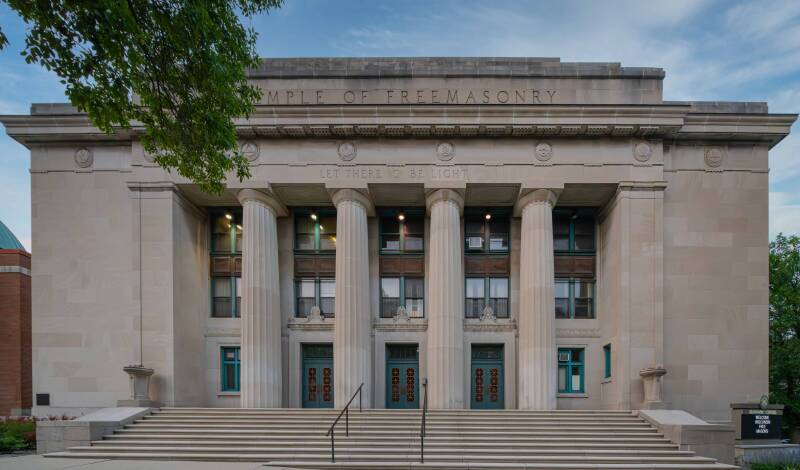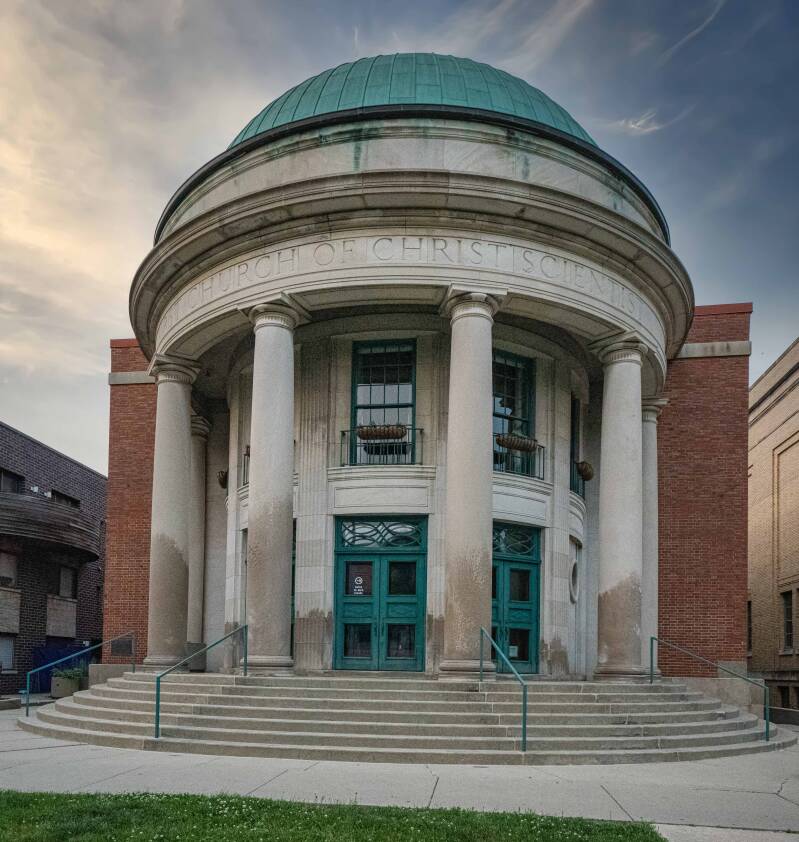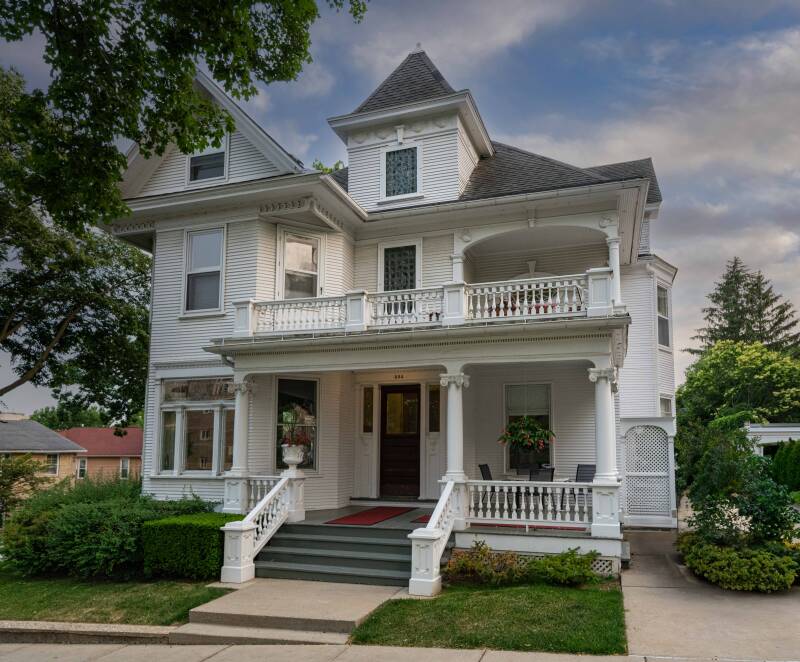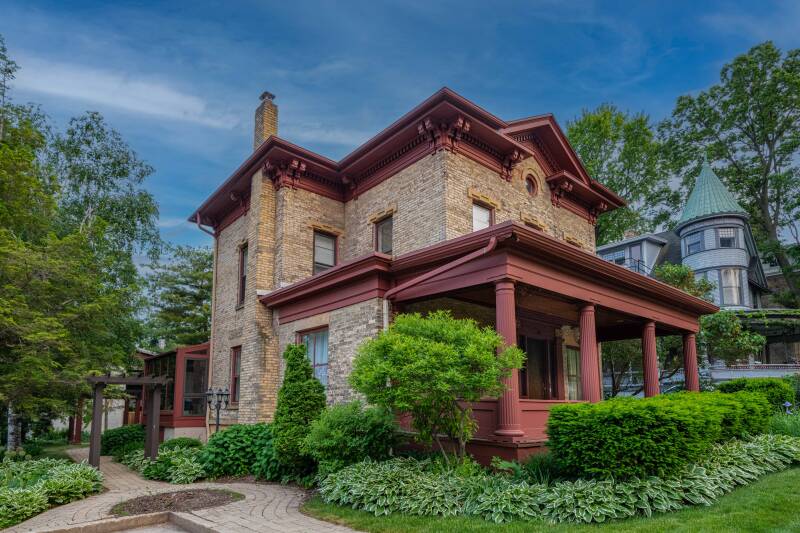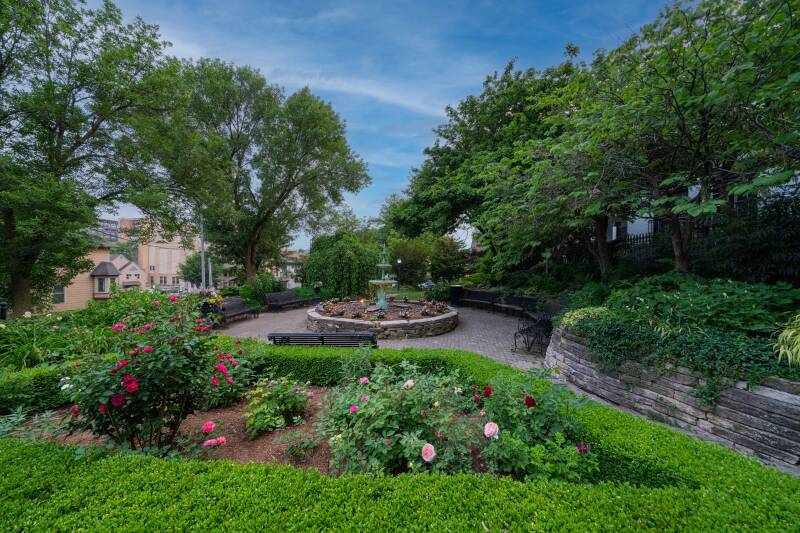The following are some photos I took on our walking tour. The information added comes from the Wisconsin Historical Society website. I thought you might like to have this in addition to Sue's information.
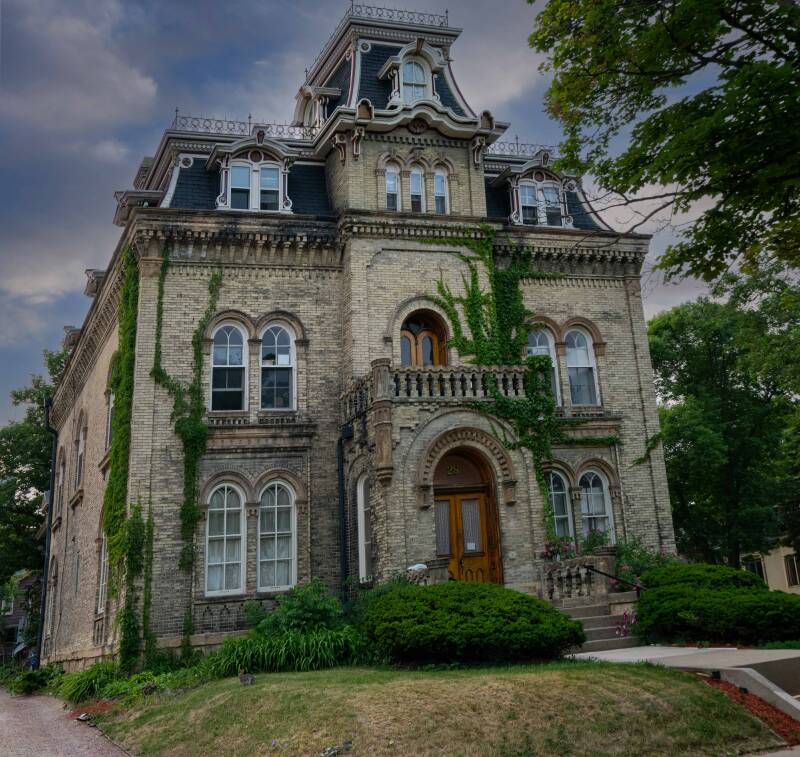
28 E Gilman St
VAN SLYKE NEVER LIVED IN THE HOUSE BECAUSE HIS WIFE DIED. Damaged by fire 1/30/1998. The original Rundbogenstil design had a profusion of round-arched windows and doors. In 1870, the owners added a mansard roof, in keeping with the Second Empire style, which was then in vogue. The roof has elaborate arched dormers and is crowned by a wrought-iron roof cresting. "The last of the four houses constructed on the Pinckney-Gilman corner is a dwelling that was designed in 1857 probably by August Kutzbock for Napoleon Bonaparte Van Slyke and his wife, Laura. However, the Yankee banker never lived in the house, and it appears that its first resident owner were Ellen and James Richardson, a close friend of the Van Slykes and a real estate speculator and banker. The original design is quite unusual and may be called German Romanesque revival. In 1870 the Second Empire style mansard roof was added. Dr. George Keenan, a prominent Madison physician and United States consul to Kiel and Bremen, Germany, and his wife, Mary, lived in the residence from 1900 to 1916."

104 E Gilman St
The John E. Kendall House, built in 1855, was similarly altered. Kutzbock designed this sandstone residence in the Italianate mode with a hipped roof and cupola. The stone hoods, with their consoles, remain above the windows. In 1873, the owners added a lavish mansard roof, a front porch (now gone), and a bay window. A mansard roof also crowns the striking three-story central entrance bay, with its ornate arched openings and its bartizaned [over hanging] balustrade at the second story. These two houses suggest how popular the Second Empire design was among wealthy American in the 1870s, who admired buildings erected during the regime of Emperor Napoleon III (1852-1870) in France. "John E. Kendall from New York built this sandstone home in 1855, the first of the four houses at the corner of Pinkney and Gilman, but he sold it six months later to land speculator James Richardson. The house was originally styled by August Kurtzbock in the Italianate mode, with a low, hipped roof and a cupola. However, in 1873 a mansard roof was added to adapt it to the modern French Second Empire style. In the late 1860s, at the height of Madison's resort era, this mansion was used as a summer home by the family of a wealthy St. Louis railroad man. Early in the 20th century, the house was graced by a frame porch across the entire front of the first floor. Ironwork with spiked finials danced along the roof line. Although not as elegant appearing as when constructed, the Kendall house remains a focal point on Mansion Hill."

130 E Gilman St
Constructed of locally quarried sandstone and designed in the Italianate style, this house was originally constructed as a private residence for Julius T. White in 1855-1856. White, the secretary of the Wisconsin Insurance Company, sold the house to fellow businessman George P. Delaplaine in 1857.
In 1868 the house was bought by millionaire lumber baron J. G. Thor, whose young daughter Sarah, married Ole Bull, the sixty year old Norwegian violinist, in one of the most lavish weddings the town had seen.
Since 1883, the State of Wisconsin has maintained an Executive Residence for the Governor. Two separate residences have served this function--the former on East Gilman Street in Madison, and the current on Cambridge Road in Maple Bluff. The first building served as the Executive Residence from 1883 to 1950, and the second from 1950 to the present. Both buildings began as private residences, and later made the transition to Executive Residences.
"The Knapp Memorial Graduate Center, built in 1856, served as the executive residence for 17 Wisconsin governors from 1885 to 1950. Through the years, it has been the scene of many elegant social functions.
Its first owners, Julius T. and Catherine White, built the Italianate style home of locally quarried sandstone. White sold the house in 1857 to one of Madison's first settlers, George P. Delaplaine and his wife, Emily. Delaplaine was secretary to Governors Farwell and Dewey and co-owner of one of the largest real estate development firms in the city. In 1867 the house rose to greater social prominence when it was purchased by State Senator J. G. Thorp, a millionaire lumber baron, and his wife Amelia. The Thorps' young daughter, Sarah, married Ole Bull, the world-famous 60-year-old Norwegian violinist in 1870 in one of the most lavish weddings the town had ever seen.
Jeremiah Rusk bought the home for $15,000 in 1883, when he was elected governor. After extensive renovations, the house was sold to the state in 1885 for a sum "not to exceed $20,000." Renovations by architects Conover and Porter in 1897 included a sweeping wrap-around veranda with Ionic columns, which was drastically reduced in size in the 1960s. The center was purchased in 1950 by the University of Wisconsin with Knapp funds.

125 E Gilman St
Daniel Campbell Residence built in 1883 in the Queen Anne style. No other information.
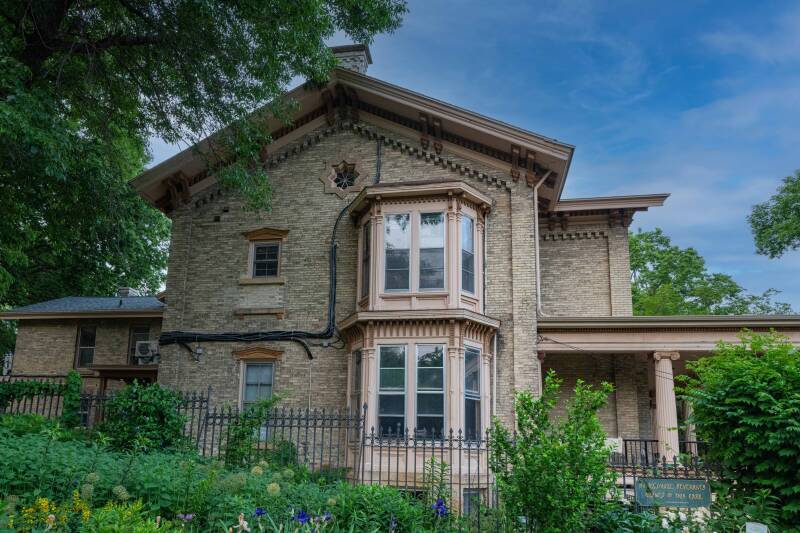
116 E Gorham St
Built during the years 1863-1865, the Timothy Brown House is a cream brick residence built in the Italianate style. Brown came to Madison in 1855 at the behest of a fellow New York stater, Napoleon Bonaparte Van Slycke, to be a part of a growing Yankee contingent in the Big Bug Hill Area. He was a co-founder of the First National Bank and an official of the Madison Gas Light and Coke Company. His real estate dealings and business investments made him one of the city's most well-known commercial figures.
Later residents of the house included three justices of the state Supreme Court: Charles V. Bardeen; Robert G. Siebecker, Chief Justice and law partner of Robert M. LaFollette; and Timothy Brown, also a Chief Justice and a grandson of the original owner.
"Built in 1863, the cream brick residence is in the Italianate style. The stately Neo-classical veranda dates to the turn-of-the-century. Timothy Brown came to Madison in 1855 at the request of a fellow New York stater, Napoleon Bonaparte Van Slyke, to be a part of growing Yankee contingent in the "Big Bug" or Mansion Hill area. Brown quickly became the cashier and principal stockholder of the Dane County Bank. With others he reorganized it into the First National Bank in 1863. In 1870, Brown took control of the floundering Madison Gas Company and turned it into a financially sound business. Brown's real estate holdings and business investments made him a well-known commercial figure and one of Madison's wealthiest people. In civic affairs, he served as treasurer of the board of regents, alderman, county supervisor, and leader of the Dane County Calvary during the Civil War. His wife, Elizabeth, continued to live in the house until her death in 1896. Mrs. Brown's house became the center of a family compound.
Later residents of the Brown family homestead included three justices of the state supreme court: Charles V. Barbeen; Robert G. Siedecker, chief justice and a law partner of Robert M. La Follette; and Timothy Brown, also a chief justice and a grandson of the original owner. A rambling carriage house is to the east.

401 N Carroll St
This multifaceted Italianate residence was built in 1864 for Madison lawyer Daniel K. Tenney. In 1871 Tenney sold the property to Breese J. Stevens who probably altered the house significantly during his ownership. There are several bay wondows to note along a meandering front porch. An early carriage house and latticed well cover may be found near the rear of the dwelling on the Gorham Street side.
Breese Stevens was an important figure in Madison's development history and served as mayor in 1884, curator of the State Historical Society, and regent of the University.
"This massive brick residence in the Italianate style was built in 1863 for Madison lawyer Daniel K. Tenney and his wife, Mary Jane, who sold the house to Breese J. and Emma Stevens in 1870. Tenney, who practiced law in Chicago from 1870 to 1897, gave a large sum for the establishment of Tenney Park. His opposition to industrialization and promotion of scenic beauty earned him the title "Madison's favorite curmudgeon."
In 1877 after marrying his second wife, M. Elizabeth, Stevens renovated the house, adding the gracious veranda and decorative bay windows. An influential lawyer, Stevens specialized in railroad, land-grant, and water litigation. He was an important figure in Madison's development and served as mayor in 1884-85, curator of the State Historical Society, and regent of the university from 1891 to 1904. Amelia E. F. Stevens, a daughter, lived here until the 1960s. The house next door at 415 N. Carroll Street was built in 1909 for daughter Elizabeth and her husband, Dr. Reginald Jackson.
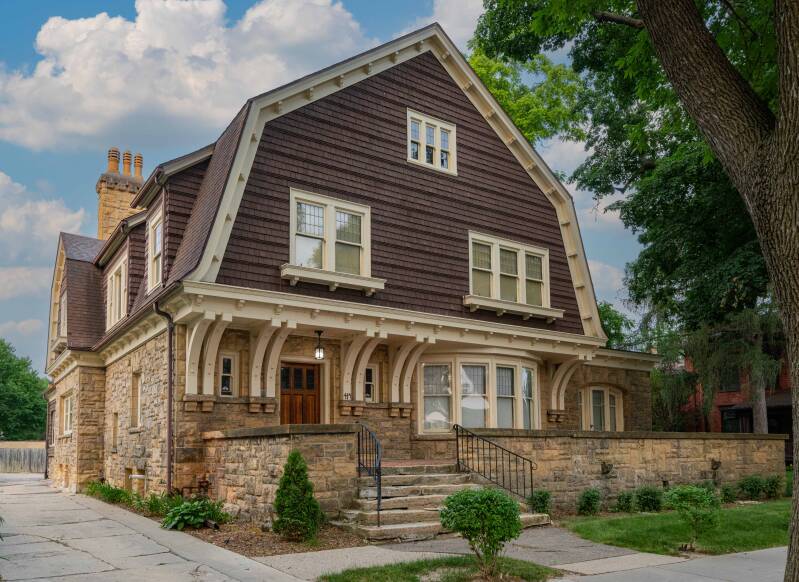
415 N Carroll St
Elizabeth S. & Dr. Reginald H. Jackson Residence Built in 1907, Dutch Colonial Style.
No other information.

510 N Carroll St
Though originally built for hardware dealer Samuel Fox and his wife Lorain in 1858, this Italianate house was acquired the next year by Napoleon Bonaparte Van Slyck, then cashier of the Dane County Bank, and his second wife, Annie. The house, a fine example of indigenous sandstone construction, is characterized by the alternating pattern of large and small stones laid up in ashlar courses, a distinctive German masonry technique. Even such details as window mouldings and porch piers are executed from Gilman to Langdon Streets.
Van Slyke continued his association with the bank after it was reorganized in 1863 as the First National Bank, serving from 1865 as its president. Van Slyke assisted in the early development of the University of Wisconsin, serving as a regent from 1848 to 1879. He also was active in the movement to erect the first city hall, in the selection of the Forest Hill Cemetery site, and in the purchase of the city's first fire engines. Van Slyke was a wheeler-dealer whose financial maneuverings sometimes raised eyebrows, but he survived the scandals and died as a revered pioneer in 1909.
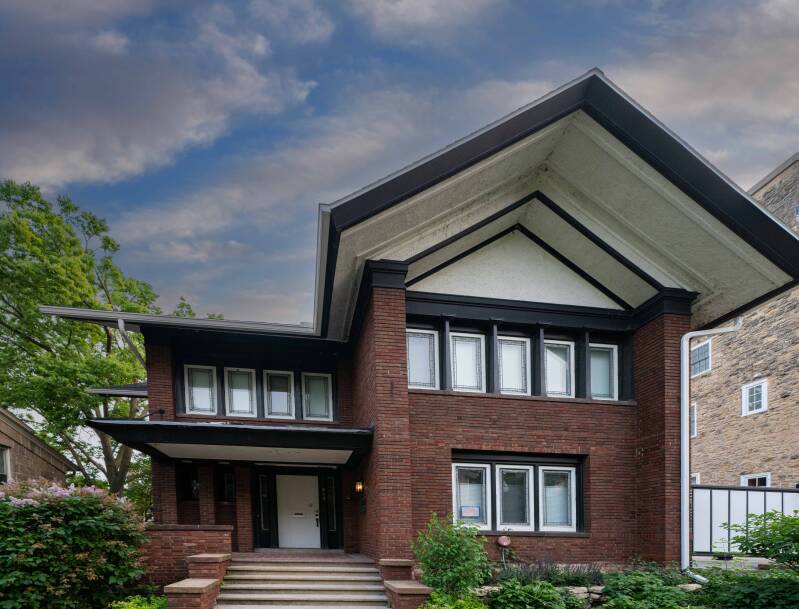
514 N Carroll St
Dr. William G. & Lucy A. Beecroft Residence built in 1911, Prairie School Style.
No other information.
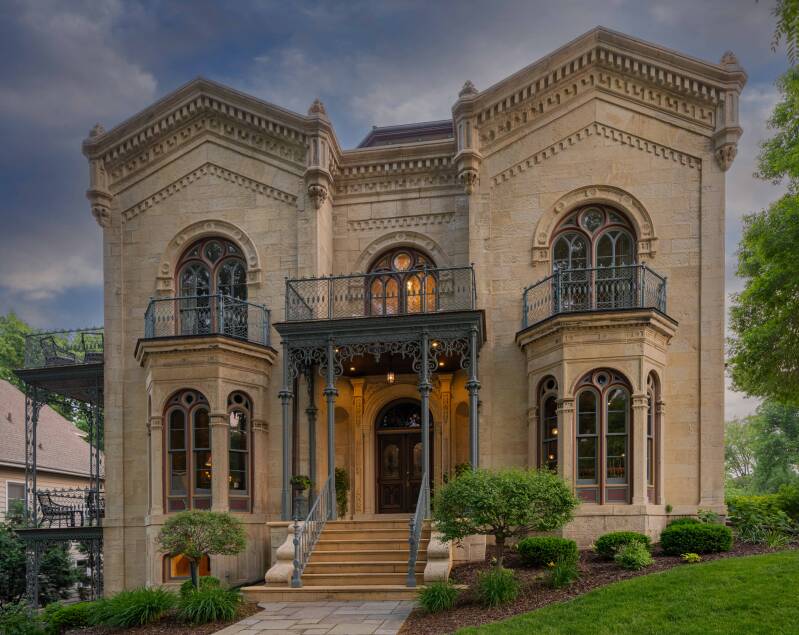
424 N Pickney St
The Alexander A. and Francie McDonnell-George and Carrie Pierce House, now the Mansion Hill Inn, was built in 1858 according to a design by Donnel and Kutzbock. They fashioned it in the mode of the Rundbogenstil, a round-arch style then popular in the German states, characterized by a combination of Romanesque and Renaissance motifs. The McDonnell-Pierce House features a pair of gabled wings with bay windows flanking the entrance, arched windows with prominent caps, and a fancifully bracketed octagonal belvedere. A torch motif at the cornice, arched tracery in the windows, and multiple corbel courses create an exuberant exterior. Supposedly the interiors were modeled after Donnel's designs for rooms in the old capitol. Madison Historic Landmark: 5/18/71. "The Mansion Hill Inn is a fine extant Romanesque Revival house built in 1857-58 for Alexander A. and Francie McDonnell. It was designed by the architectural partnership of Samuel Hunter Donnel and August Kutzbock. The ornate stonework closely parallels that of the second copitol in Madison, for which McDonell was the contractor in 1857-59, Donnel and Kutzbock the architects, and the same Prairie du Chien sandstone the same building material. Many of the decorative details on the house are said to be duplicates of designs used in the old state capitol building. The house may well be the finest domestic example of the German Romanesque revival remaining in the United States. Among the former residents of the house were Rebecca and J. H. Garnhart, owner of the Garnhart Reaper Works; Orasmus Cole, Wisconsin Supreme Court justice who married Garnhart's widow; and Sarah Fairchild Dean Conover (sister of Governor Fairchild), who was influential in civic, social, and political activities. During the latter half of the 19th century, the house was the scene of many elegant social events. George and Carrie Pierce used it as their residence and boarding house from 1906 to 1938. The Alexander Company converted it to a luxury hotel in 1985
The following images are places we visited, but I have found no information to add.



